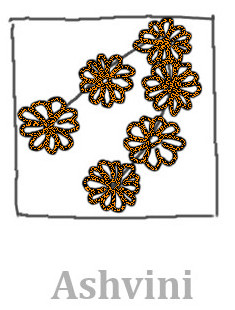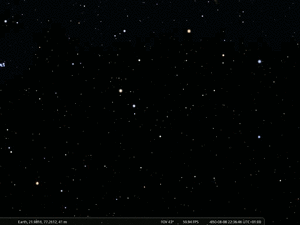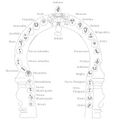Ashvini: Difference between revisions
No edit summary |
|||
| (10 intermediate revisions by the same user not shown) | |||
| Line 1: | Line 1: | ||
{{DISPLAYTITLE: Aśvini (अश्विनी)}} |
{{DISPLAYTITLE: Aśvini (अश्विनी)}} |
||
[[File:Ashvini nakshatras in Temple draw+lbl 4ase.jpg|thumb|Ashvini nakshatra in Tirupperunthurai (Athmanathaswamy temple) near Aranthangi, India, 10th century CE. (SMH 2025).]] |
|||
[[File:1 Ashvini stellarium.gif|thumb|Ashvini drawing in the stars, animated GIF (SMH 2025)]] |
[[File:1 Ashvini stellarium.gif|thumb|Ashvini drawing in the stars, animated GIF (SMH 2025)]] |
||
Aśvini is the name of an Indian twin deity that is asscoiated with the first nakshatra. As gods they initially represent physicians; as asterism they are associated with the star β and γ Arietis in [[Aries]]. However, the oldest reconstruction of the image shows a horse head with three stars, suggesting that α Arietis might also have belonged to the asterism. |
Aśvini (अश्विनी) is the name of an Indian twin deity that is asscoiated with the first nakshatra. As gods they initially represent physicians; as asterism they are associated with the star β and γ Arietis in [[Aries]]. However, the oldest reconstruction of the image shows a horse head with three stars, suggesting that α Arietis might also have belonged to the asterism. |
||
==Etymology and History== |
==Etymology and History== |
||
'''Name Variant:''' |
'''Name Variant:''' |
||
*Adya, |
|||
*Dasra |
|||
*Asva, |
|||
*Asvi, |
|||
*Dasra, |
|||
*Hari, |
|||
*Haya, |
|||
*Turaga, |
|||
*Turanaga, |
|||
*Vaaji |
|||
[[File:Ashwini Kumaras-L.jpg|thumb|The Ashwini kumaras twins, sons of the sun god Surya. Vedic gods representing the brightness of sunrise and sunset]] |
[[File:Ashwini Kumaras-L.jpg|thumb|The Ashwini kumaras twins, sons of the sun god Surya. Vedic gods representing the brightness of sunrise and sunset]] |
||
===Origin of Constellation=== |
===Origin of Constellation=== |
||
Asvini is mythologically associated with twin physicians of the Gods |
Asvini actually means "twin horse-man". It is mythologically associated with twin physicians of the Gods and as an astrism represented with a horse head. All alternative names of the nakshatra mean "horse" and so does the word “aśva” (अश्व) . |
||
====Identification==== |
====Identification==== |
||
| Line 17: | Line 26: | ||
(perhaps also α Ari in some variants, as sometimes three stars are drawn) |
(perhaps also α Ari in some variants, as sometimes three stars are drawn) |
||
{| class="wikitable" |
|||
|+ |
|||
! |
|||
!Ashvini |
|||
Vedic |
|||
!Ashvini in |
|||
Tirupperunthurai |
|||
!Ashvini |
|||
Chinese |
|||
!Ashvini |
|||
(Jones 1790) |
|||
|- |
|||
| |
|||
|≥ 2 stars |
|||
|6 stars |
|||
|3 stars |
|||
|3 stars |
|||
|} |
|||
==== Stars within the Constellation Area ==== |
|||
{| class="wikitable sortable mw-collapsible" |
|||
|+ |
|||
|- |
|||
!id |
|||
!Label |
|||
!HIP |
|||
! description |
|||
!Vmag |
|||
|- |
|||
|1 |
|||
|Hamal |
|||
|HIP 9884 |
|||
|Constellation lines (Vertex) |
|||
|2.01 |
|||
|- |
|||
|2 |
|||
|Sheratan |
|||
|HIP 8903 |
|||
|Constellation lines (Vertex) |
|||
|2.65 |
|||
|- |
|||
|3 |
|||
|Mesarthim |
|||
|HIP 8832 |
|||
|Constellation lines (Vertex) |
|||
|4.52 |
|||
|- |
|||
|4 |
|||
|* gam01 Ari |
|||
| HIP 8832 |
|||
|Constellation lines (Vertex) |
|||
|4.589 |
|||
|- |
|||
|5 |
|||
|κ Arietis |
|||
|HIP 9836 |
|||
|Inside the hull |
|||
| 5.019 |
|||
|- |
|||
|6 |
|||
| ι Arietis |
|||
|HIP 9110 |
|||
|Constellation lines (Vertex) |
|||
|5.105 |
|||
|- |
|||
|7 |
|||
|η Arietis |
|||
|HIP 10306 |
|||
| Constellation lines |
|||
| 5.2 |
|||
|- |
|||
|8 |
|||
|θ Arietis |
|||
|HIP 10732 |
|||
|Constellation lines (Vertex) |
|||
|5.572 |
|||
|- |
|||
|9 |
|||
|15 Ari |
|||
|HIP 10155 |
|||
|Inside the hull |
|||
|5.688 |
|||
|- |
|||
|10 |
|||
| - |
|||
|HIP 9307 |
|||
|Inside the hull |
|||
| 5.892 |
|||
|} |
|||
===Transfer and Transformation of the Constellation=== |
===Transfer and Transformation of the Constellation=== |
||
<gallery> |
<gallery> |
||
| Line 24: | Line 121: | ||
File:婁宿(仏像図彙).png|Ashvini (Chinese) |
File:婁宿(仏像図彙).png|Ashvini (Chinese) |
||
File:1 ashvini draw.png|Ashvini reconstructed by Jones (1720). |
File:1 ashvini draw.png|Ashvini reconstructed by Jones (1720). |
||
File:Nakshatra temple magDraw lbl.jpg|Display of all 28th nakshatra in silver arch with candles in Tirupperunthurai (Athmanathaswamy temple) near Aranthangi, India, 10th century CE. (SMH 2025). |
|||
File:Nakshatras in Temple draw+lbl 4ase.jpg|Display of all 28th nakshatra in a door frame in Tirupperunthurai (Athmanathaswamy temple) near Aranthangi, India, 10th century CE. (SMH 2025). |
|||
</gallery> |
</gallery> |
||
| Line 43: | Line 142: | ||
[[Category:South Asian]] |
[[Category:South Asian]] |
||
[[Category:Zodiac]] |
[[Category:Zodiac]] |
||
[[Category:Ari]] |
|||
Latest revision as of 17:05, 14 December 2025
Aśvini (अश्विनी) is the name of an Indian twin deity that is asscoiated with the first nakshatra. As gods they initially represent physicians; as asterism they are associated with the star β and γ Arietis in Aries. However, the oldest reconstruction of the image shows a horse head with three stars, suggesting that α Arietis might also have belonged to the asterism.
Etymology and History
Name Variant:
- Adya,
- Asva,
- Asvi,
- Dasra,
- Hari,
- Haya,
- Turaga,
- Turanaga,
- Vaaji
Origin of Constellation
Asvini actually means "twin horse-man". It is mythologically associated with twin physicians of the Gods and as an astrism represented with a horse head. All alternative names of the nakshatra mean "horse" and so does the word “aśva” (अश्व) .
Identification
β, γ Arietis are certain,
(perhaps also α Ari in some variants, as sometimes three stars are drawn)
| Ashvini
Vedic |
Ashvini in
Tirupperunthurai |
Ashvini
Chinese |
Ashvini
(Jones 1790) | |
|---|---|---|---|---|
| ≥ 2 stars | 6 stars | 3 stars | 3 stars |
Stars within the Constellation Area
| id | Label | HIP | description | Vmag |
|---|---|---|---|---|
| 1 | Hamal | HIP 9884 | Constellation lines (Vertex) | 2.01 |
| 2 | Sheratan | HIP 8903 | Constellation lines (Vertex) | 2.65 |
| 3 | Mesarthim | HIP 8832 | Constellation lines (Vertex) | 4.52 |
| 4 | * gam01 Ari | HIP 8832 | Constellation lines (Vertex) | 4.589 |
| 5 | κ Arietis | HIP 9836 | Inside the hull | 5.019 |
| 6 | ι Arietis | HIP 9110 | Constellation lines (Vertex) | 5.105 |
| 7 | η Arietis | HIP 10306 | Constellation lines | 5.2 |
| 8 | θ Arietis | HIP 10732 | Constellation lines (Vertex) | 5.572 |
| 9 | 15 Ari | HIP 10155 | Inside the hull | 5.688 |
| 10 | - | HIP 9307 | Inside the hull | 5.892 |
Transfer and Transformation of the Constellation
Mythology
mnemonic tales and cultural significance
Weblinks
References
- References (general)












